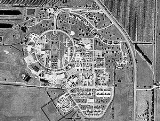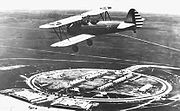
Carlstrom Field
Encyclopedia

Newport News, Virginia
Newport News is an independent city located in the Hampton Roads metropolitan area of Virginia. It is at the southeastern end of the Virginia Peninsula, on the north shore of the James River extending southeast from Skiffe's Creek along many miles of waterfront to the river's mouth at Newport News...
. At the outbreak of World War I
World War I
World War I , which was predominantly called the World War or the Great War from its occurrence until 1939, and the First World War or World War I thereafter, was a major war centred in Europe that began on 28 July 1914 and lasted until 11 November 1918...
, he was one of the foremost aviators of his time. He made many first flights and set many altitude and distance records. On 9 May 1917, Carlstrom and a student pilot were killed when the wing of the aircraft he was piloting failed in flight.
World War I
Opened in 1917, the airfield was used as a World War IWorld War I
World War I , which was predominantly called the World War or the Great War from its occurrence until 1939, and the First World War or World War I thereafter, was a major war centred in Europe that began on 28 July 1914 and lasted until 11 November 1918...
pilot training facility. The airfield facilities consisted of a total of 90 buildings & structures, Including a row of hangars located along a square mile grass field. This site consisted of a total of 696 acres (2.8 km²).
After the Armistice, Carlstrom Field served as a testing area for various aircraft, dirgibles, and other aeronautical weapons. In October 1919, final testing of an experimental unmanned aircraft called the "Kettering Bug", one of the earliest examples of a cruise missile, was successfully tested & launched at Carlstrom Field. The airfield also served as the United States Army Air Service
United States Army Air Service
The Air Service, United States Army was a forerunner of the United States Air Force during and after World War I. It was established as an independent but temporary wartime branch of the War Department by two executive orders of President Woodrow Wilson: on May 24, 1918, replacing the Aviation...
's principal flying school until 1923 when it was closed. All of the buildings were sold to private individuals & removed by 1926.
World War II
With the need for primary pilot training brought on by World War IIWorld War II
World War II, or the Second World War , was a global conflict lasting from 1939 to 1945, involving most of the world's nations—including all of the great powers—eventually forming two opposing military alliances: the Allies and the Axis...
, Carlstrom re-opened in March 1941 under the operation of Riddle Aeronautical Institute
Embry-Riddle Aeronautical University
Embry-Riddle Aeronautical University is a private university in the US specializing in aviation and aerospace engineering. It teaches the science, practice, and business of aviation and aerospace. Called "The Harvard of the Sky" by Time Magazine in 1979, Embry-Riddle has a history dating back to...
. A new facility was built adjacent to the remains of World War I-era facilities and Riddle contracted to train Royal Air Force
Royal Air Force
The Royal Air Force is the aerial warfare service branch of the British Armed Forces. Formed on 1 April 1918, it is the oldest independent air force in the world...
aviators and graduated the first class in August 1941.
Carlstrom Field had a very unusual layout, with a compact group of buildings located inside a circular road, with five hangars located around the southern periphery of the road. No paved runway was ever built with the flying conducted from the 1 square miles (2.6 km²) grass field.
Postwar use
Closed after the war, Carlstrom Field became the site of the G. Pierce Wood Memorial Hospital in 1947. Many of World War II era buildings remain in use by the hospital, with former six-plane hangars serving as maintenance buildings. The band shell, site of dances and other entertainment during the war, remains on the site.In 2002, the G. Pierce Wood Memorial Hospital was closed and operates today as the Desoto County Juvenile Correctional Complex. The only remembrance of Carlstrom field today is a plaque on the administration building placed when it was refurbished by the state of Florida in 1992, and a tired B-17 weather vane on top of the building.
The Oak Ridge Cemetery in Arcadia is the final resting-place of twenty-three RAF cadets who died while in the United States for training. A special marker at the cemetery recognizes their service and a ceremony is held in their memory each year on Memorial Day.
Though the original World War II blueprints called for six hangars at Carlstrom Field, only five were ever constructed. Of those five, the two built first survive. Also still standing are the mess hall, band shell, canteen, administration building, water and sewage plants, and two training buildings. All that remains from World War I version of Carlstrom Field are concrete pads along Highway 31 upon which the wooden hangars stood, and across the highway, on private property, is a concrete full-scale outline of a World War I biplane that is approximately one foot tall. It was used for target practice by filling it up with water and cadets would shoot at it from the air and be able to see "hits" when their bullets struck the water.
See also
- Florida World War II Army Airfields

